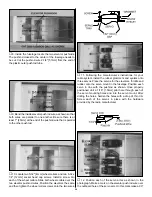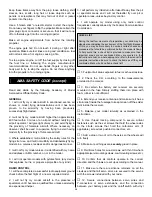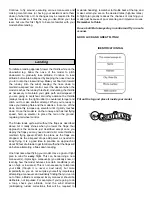
tape, heat shrink tubing or special clips suitable for that
purpose.
❏
13. Make sure any servo extension cords you may have
used do not interfere with other systems (servo arms,
pushrods, etc.).
❏
14. Secure the pressure tap (if used) to the muffler with
high temp RTV silicone, thread locking compound or
J.B. Weld.
❏
15. Make sure the fuel lines are connected properly and
are not kinked.
❏
16. Use an incidence meter to check the wing for twists
and attempt to correct before flying.
❏
17. Balance your propeller (and spare propellers).
❏
18. Tighten the propeller nut and spinner.
❏
19. Place your name, address, AMA number and
telephone number on or inside your model.
❏
20. Cycle your receiver battery pack (if necessary) and
make sure it is fully charged.
❏
21. If you wish to photograph your model, do so before
your first flight.
❏
22. Always range check your radio when you get to the
flying field.
The Stuka is a great-flying model that flies smoothly and
predictably. The Stuka does not, however, possess the self-
recovery characteristics of a primary R/C trainer and should
be flown only by experienced R/C pilots.
A fully cowled engine may run at a higher temperature than
an un-cowled engine. For this reason, the fuel mixture
should be richened so the engine runs at about 200 rpm
below peak speed. By running the engine slightly rich, you
will help prevent dead-stick landings caused by overheating.
Before you get ready to takeoff, see how the model handles
on the ground by doing a few practice runs at low speeds
on the runway. Hold “up” elevator to keep the tail wheel on
the ground. If necessary, adjust the tail wheel so the model
will roll straight down the runway. If you need to calm your
nerves before the maiden flight, shut the engine down and
bring the model back into the pits. Top off the fuel, then
check all fasteners and control linkages for peace of mind.
Remember to takeoff into the wind. When you’re ready, point
the model straight down the runway, hold a bit of up elevator
to keep the tail on the ground to maintain tail wheel steering,
then gradually advance the throttle. As the model gains
speed, decrease up elevator allowing the tail to come off the
ground. One of the most important things to remember with
a taildragger is to always be ready to apply right rudder to
counteract engine torque. Gain as much speed as your
runway and flying site will practically allow before gently
applying up elevator, lifting the model into the air. At this
moment it is likely that you will need to apply more right
rudder to counteract engine torque. Be smooth on the
elevator stick, allowing the model to establish a gentle climb
to a safe altitude before turning into the traffic pattern.
For reassurance and to keep an eye on other traffic, it is a
good idea to have an assistant on the flight line with you. Tell
him to remind you to throttle back once the plane gets to a
comfortable altitude. While full throttle is usually desirable for
takeoff, most models fly more smoothly at reduced speeds.
Take it easy with the Stuka for the first few flights, gradually
getting acquainted with it as you gain confidence. Adjust the
trims to maintain straight and level flight. After flying around
for a while, and while still at a safe altitude with plenty of fuel,
practice slow flight and execute practice landing approaches
by reducing the throttle to see how the model handles at
slower speeds. Add power to see how she climbs as well.
Flight
Takeoff
CAUTION (THIS APPLIES TO ALL R/C AIRPLANES): If, while
flying, you notice any unusual sounds, such as a low-pitched
“buzz,” this may indicate control surface
flutter. Because flutter
can quickly destroy components of your airplane, any time you
detect flutter you must immediately cut the throttle and land the
airplane! Check all servo grommets for deterioration (this may
indicate which surface fluttered), and make sure all pushrod
linkages are secure and free of play. If the control surface
fluttered once, it probably will flutter again under similar
circumstances unless you can eliminate the free-play or flexing
in the linkages. Here are some things which can cause flutter:
Excessive hinge gap; Not mounting control horns solidly; Poor fit
of clevis pin in horn; Side-play of pushrod in guide tube caused
by tight bends; Poor fit of Z-bend in servo arm; Insufficient glue
used when gluing in the elevator joiner wire; Excessive
play or
backlash in servo gears; and insecure servo mounting.
Fuel Mixture Adjustments
FLYING
31


































